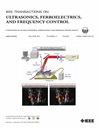Rationally Designed Acoustic Holograms for Uniform Nanodroplet-Mediated Tissue Ablation
IF 3
2区 工程技术
Q1 ACOUSTICS
IEEE transactions on ultrasonics, ferroelectrics, and frequency control
Pub Date : 2024-10-01
DOI:10.1109/TUFFC.2024.3471873
引用次数: 0
Abstract
Nanodroplets (NDs) are phase-changing agents that have shown great potential for ultrasound (US) applications. When US is applied, NDs can undergo a phase transition into gas bubbles, enabling cavitation that can be used to reduce the pressure threshold required for mechanical ablation of tissues. Effective tissue fractionation depends on precise vaporization to achieve uniform and predictable bubble formation. This study aimed to optimize ND vaporization using acoustic holograms for improved ND-mediated histotripsy. Tissue ablation was conducted using a two-step approach, where a rotating imaging probe was used for ND vaporization followed by low-frequency US for detonation. We developed and validated three distinct acoustic hologram patterns targeting different regions within a circular area through simulations and experiments. Using custom-made gelatin phantoms designed for optimal ND vaporization imaging, the superpositioned patterns demonstrated significantly more uniform ND vaporization compared to standard single-focus steering, with ND coverage reaching合理设计声全息图,实现均匀的纳米微滴介导的组织消融。
纳米微滴是一种相变剂,在超声波应用方面具有巨大潜力。应用超声波时,纳米液滴会发生相变,变成气泡,从而产生空化作用,可用于降低机械消融组织所需的压力阈值。有效的组织分馏取决于精确的气化,以实现均匀和可预测的气泡形成。本研究旨在利用声全息技术优化纳米液滴汽化,以改进纳米液滴介导的组织切割。组织消融采用两步法进行,先用旋转成像探针进行纳米微滴汽化,然后用低频超声引爆。通过模拟和实验,我们开发并验证了针对圆形区域内不同区域的三种不同声全息图模式。使用为纳米液滴汽化最佳成像而设计的定制明胶模型,与标准的单焦点转向相比,叠加模式显示出更均匀的纳米液滴汽化,优化汽化方法的纳米液滴覆盖率达到 70.42 ± 6.86%,而单焦点转向的覆盖率为 39.32 ± 6.77%。体内鸡肝实验证实,优化方法的效率更高,产生的病变区域更大、更均匀。120 秒治疗产生的病变面积达到 2.19 ± 0.21 平方毫米,而标准方法为 0.43 ± 0.03 平方毫米,增加了 5.1 倍。这些研究结果表明,使用声全息图可以改善纳米微滴汽化的均匀性,提高组织分馏的均匀性,从而有可能提高治疗效果。
本文章由计算机程序翻译,如有差异,请以英文原文为准。
求助全文
约1分钟内获得全文
求助全文
来源期刊
CiteScore
7.70
自引率
16.70%
发文量
583
审稿时长
4.5 months
期刊介绍:
IEEE Transactions on Ultrasonics, Ferroelectrics and Frequency Control includes the theory, technology, materials, and applications relating to: (1) the generation, transmission, and detection of ultrasonic waves and related phenomena; (2) medical ultrasound, including hyperthermia, bioeffects, tissue characterization and imaging; (3) ferroelectric, piezoelectric, and piezomagnetic materials, including crystals, polycrystalline solids, films, polymers, and composites; (4) frequency control, timing and time distribution, including crystal oscillators and other means of classical frequency control, and atomic, molecular and laser frequency control standards. Areas of interest range from fundamental studies to the design and/or applications of devices and systems.

 求助内容:
求助内容: 应助结果提醒方式:
应助结果提醒方式:


